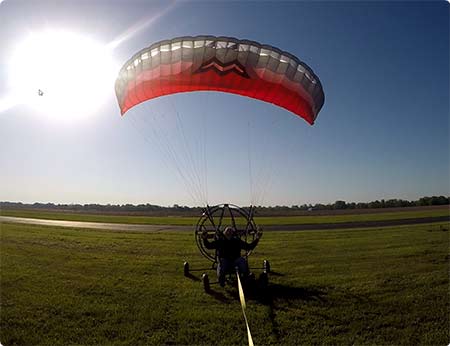Wheel Launch Training Details
Course Price - $3250
Wheel launch training includes the same core curriculum as foot launch. The major difference is how glider ground handling is taught. While we encourage all pilots to learn how to kite their glider on foot, our wheel launch training course is very sensitive to students with difficulty spending long periods of time on their feet. Aspiring pilots with knee or back problems, or other physical limitations, will find our wheel launch program both a comfortable and enjoyable path to flight.
Pilots who choose to launch on trike or quad can expect to spend 7-8 days (consecutive) in the training process. This includes an extensive ground school, 3-6 hours of tow & powered 'kiting', then finally a series of 15-20 flights with progressively less instructor input. When you leave us, you'll be ready to safely and confidently identify suitable flying sites and weather, and launch, fly and land unsupervised.
Beginner wheel launch pilots have a narrower weather window in which to fly. Specifically, lighter winds are required at first. However, wheel launch pilots leave us with the same experience and confidence as our foot launch pilots.
Ready to Fly?
If you're ready to take the first steps towards flight or still have questions, fill out our New Pilot Training Application. We will get back to you to schedule a training date or assist you in any way.
New Pilot Training ApplicationOur course of instruction meets or exceeds the USPPA PPG1 & PPG2 Wheel Launch Program.

Ground School
Aerodynamic Principles and Glider Dynamics
Understanding how and why a wing flies is as important as knowing how to fly it. Students will learn the fundamentals of aerodynamics and the nuances and considerations of flying the special type of aircraft we fly.
Federal Airspace
Just like on the road, there are rules in the sky. It's important for pilots to know how to safely and accurately navigate the different airspaces over the United States. You'll learn how to read FAA Sectional Charts, identify and avoid dangerous and prohibited areas, and scout out future flying trips away from your home field.
Weather
One of the most critical skills a pilot can develop is an understanding of the weather. Our ability to fly safely depends on our ability to know the best weather conditions from the worst. Students will learn both macro- and micro-weather considerations and how to use all available resources to fly in safe air.
FAR Part 103
As Ultralight Pilots, we're governed by Federal Aviation Regulation Part 103. All Paramotor pilots should know and understand these regulations in order to confidently fly your aircraft without fear of accidentally violating a law you didn't know existed.
Safety
Being a safe pilot is a mindset. Not only will we give you the skills to fly safely, we'll teach you consistent pre- and post- flight safety checks, and the psychology necessary for a long career as a competent aviator.
Glider Handling Skills
Before a new pilot even attempts to fly, its necessary to have complete control of the glider on the ground. Wheel launching students will learn to inflate and hold their wing overhead during taxi and how to successfully transition from taxi to flight.
Successfully kiting the wing is one of the most challenging parts of training, but it's also a lot of fun to learn. Everyone picks it up at a different pace, but usually by the end of day 2, new students are getting the hang of it.

Your First Flights

Wheel launch training consists of the same core subject matter as foot launch. The main difference is in ground handling the glider. While wheel launch students are encouraged to learn ground handling to the degree of a foot launch pilot, wheel launch training is more sensitive to issues that might prevent a student from spending hours on their feet, like knee and back injuries.
Prior to solo, students rehearse their first flight, from beginning to end on the ground. There won't be any surprises when you take to the air for the first time and see the world from a whole new vantage. Solo day is the day we've been looking forward to, and for us as instructors, it's the most rewarding part of training.
After solo day, pilot confidence will increase rapidly as we continue to refine take-offs and landings. By flights 7 to 10, your instructors will begin stepping out of the process and allowing pilots to progress towards totally independent flight. Between 12 and 15 flights, we’ll start thinking about sending you home to finish developing your skills on your own, but we’re always available to talk over weather and flight considerations as needed.

Midwest Powered Paragliding
(317) 296-7888 call or text
Office Hours (OFFSITE):
Open : 9 am - 5 pm EST
Sunday-Monday-Wednesday-Thursday-Saturday
Closed : Tuesday and Friday
Field Hours:
Hours at the training facility vary due to weather and training schedules. Please call prior to coming.
Mailing Address:
7851 Shannon Lakes Way
Indianapolis, IN 46217
Training Facility:
3477 S 200 E
Franklin, IN 46131



